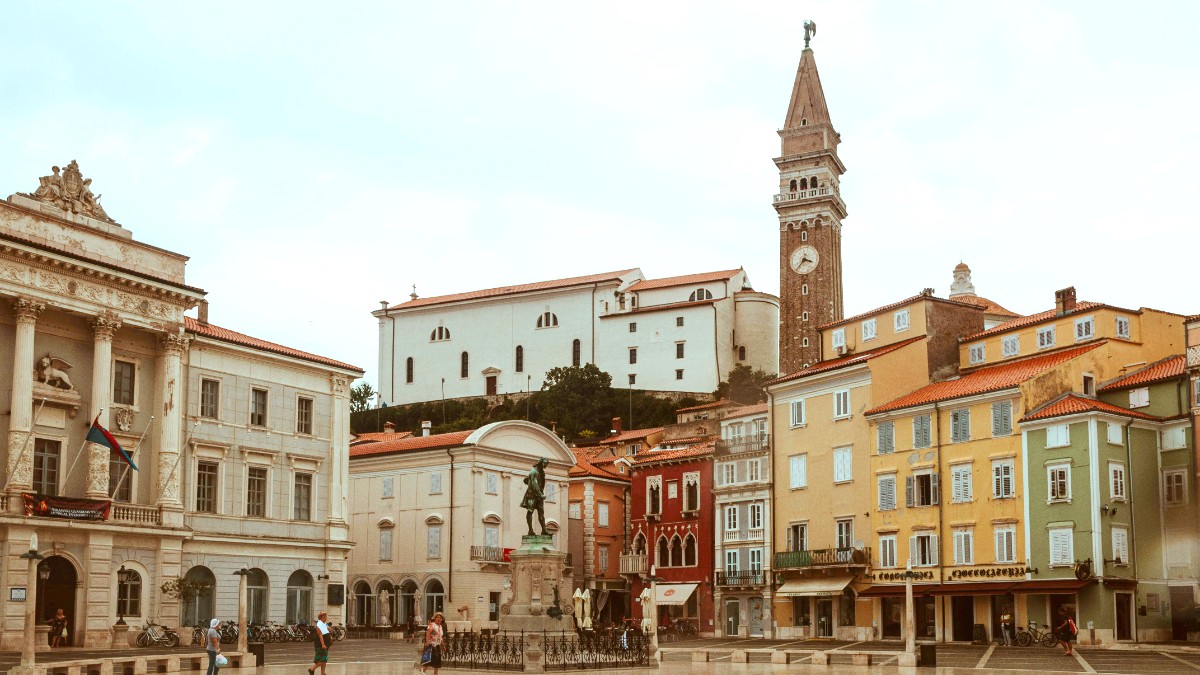
Karst And Coast, Slovenia
Cobblestone streets wind through ancient buildings, their colorful facades reflecting centuries of history. The scent of salt and fresh seafood hangs in the air, carried by a gentle breeze off the Adriatic. Church bells chime, blending with distant calls of gulls and the murmur of conversations from outdoor cafes. This is Piran, where every turn presents a picturesque scene, inviting you to slow down and absorb its timeless beauty. This small, pedestrian-only town welcomes visitors, showing a way of life shaped by the sea and a rich past.
Piran's history reaches back to ancient times, with evidence of Roman settlements. Its identity was profoundly shaped by over five centuries of Venetian rule, beginning in 1283. During this period, Piran became a part of the Venetian Republic's maritime network, thriving on trade, especially salt production from the nearby Sečovlje salt pans.
This long Venetian influence is strikingly evident in the town's architecture: narrow, winding streets, colorful houses with Venetian-Gothic windows, and prominent Lion of St. Mark crests throughout the old town. Tartini Square, the town's central plaza, was once an inner harbor before being filled in. After World War II, Piran became part of Yugoslavia. Since Slovenia's independence in 1991, Piran is a symbol of Slovenia's Adriatic heritage, carefully preserving its historical fabric. The continued use of the Sečovlje salt pans provides another tangible link to Piran's historical economic backbone.
Piran offers a captivating experience, blending historical depth with laid-back coastal charm. Visitors mainly explore its pedestrian-only old town, a maze of narrow streets that open onto charming squares and sea views. Above the square, the commanding presence of St. George's Church and its bell tower welcomes a climb for sweeping panoramic views of the town, the sea, and the coasts of Italy and Croatia. Remnants of the old town walls provide another elevated perspective, presenting Piran's defensive past and its strategic importance.
The town's small harbor hosts fishing boats and pleasure craft, while the promenade extends along the waterfront, leading to the Piran Lighthouse at the peninsula's tip – a popular spot for sunset viewing. Dining focuses on fresh Adriatic seafood, often served in charming waterfront restaurants. Local wines, specifically Malvazija and Refošk, accompany meals. Piran's atmosphere combines Italian flair with Slovenian efficiency, creating a welcoming and safe environment for travelers.
A modern resort town, easily accessible for a change of pace.
A historic fishing town with a relaxed atmosphere.
A larger port city offering different cultural and urban experiences.
Explore the historic salt pans and diverse birdlife.
Known for dramatic cliffs and coastal walking trails.
Piran is an ideal destination for a relaxing getaway, cultural exploration, or a base for discovering the broader Slovenian coast and Karst region. The town's compact size makes for easy navigation, and its car-free status in the historic core establishes a peaceful environment for wandering.
The town's small size means travel from one end to the other, from the bustling harbor to the tranquil lighthouse point, finding new perspectives and moments of calm at each step.
The town's commitment to preserving its historical core means that its narrow alleys and Venetian-influenced architecture remain largely as they were centuries ago, a genuine backdrop for your travel memories.
This coastal gem is not merely a destination; it presents an experience, a feeling of stepping back in time while enjoying the comforts of the present.
Careful planning establishes a fulfilling visit to Piran. Find information on the best times to experience the town's charm, requirements for entry, ways to manage your budget, and tips for staying healthy and safe throughout your stay.
Piran has a Mediterranean climate, with warm summers and mild, wet winters. Shoulder seasons (May-June, Sept-Oct) for pleasant weather and fewer crowds.
Slovenia is part of the Schengen Area. Check visa requirements based on your nationality. Passports need 3 months validity beyond departure.
Slovenia uses the Euro (€). ATMs are widespread. Budget traveler daily costs range from €40-€70.
Travelers from non-EU/EEA/Swiss countries without visa-free access need a Schengen Visa. This short-stay visa allows stays up to 90 days within any 180-day period across all Schengen countries. From mid-2025, visa-exempt non-EU nationals will need an ETIAS authorization.